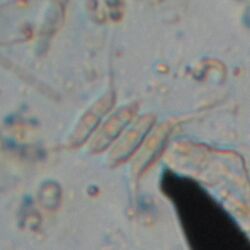Biology:Desmodesmus
| Desmodesmus | |
|---|---|

| |
| Desmodesmus armatus | |
| Scientific classification | |
| (unranked): | Viridiplantae |
| Division: | Chlorophyta |
| Class: | Chlorophyceae |
| Order: | Sphaeropleales |
| Family: | Scenedesmaceae |
| Genus: | Desmodesmus (Chodat) S.S.An, T.Friedl & E.Hegewald |
| Species | |
| |
Desmodesmus is a genus of green algae in the family Scenedesmaceae.[1] It is the only chlorophyll-containing organism known to have caused human infections in immunocompetent individuals. All known cases involved open injuries occurring in fresh water.[2]
Morphology
Desmodesmus consists of colonies of two, four, eight or 16 cells arranged in a row. Cells are ellipsoidal to ovoid, joined to each other by their longer sides. The terminal cells of a colony (and sometimes the medial cells as well) are usually armed with spines. Cell walls may also be covered in ridges, warts, and net-like structures. Cells contain one parietal chloroplast, containing one pyrenoid.[3]
Desmodesmus species usually produce colonies of more than one cell, but single cells (unicells) may be found as well.[4] These single cells may be confused with Lagerheimia, a genus of single-celled algae.[5]
The cell wall of Desmodesmus consists of an outer layer with a net-like structure, with "rosettes" of tubes underneath.[6] These structures are not visible under light microscopy, and only become visible under a scanning electron microscope (SEM) or transmission electron microscope.[7]
Reproduction
Desmodesmus typically reproduces asexually by forming autospores.[4] Sexual reproduction has been observed a few times.[4]
Taxonomy
Species in the genus Desmodesmus have long been placed in the related genus Scenedesmus.[4] However, Scenedesmus was found to be polyphyletic, and was split up into several genera (corresponding to the subgenera within Scenedesmus). Desmodesmus has ornamented cell walls, while Scenedesmus sensu stricto lacks ornamentation.[7]
A factor that has long complicated the taxonomy of Scenedesmus and its related taxa is the fact that these algae show considerable phenotypic plasticity. This plasticity has led taxonomists in the past to designate thousands of infraspecific names based on minute changes in spine morphology or cell shape.[4] However, in laboratory conditions the same strain may produce an array of different morphologies.[4]
Currently, Desmodesmus species are delimited using a combination of ultrastructural features and molecular data. In particular, the locus ITS-2 provides enough variability to distinguish between species.[8]
Habitat
Desmodesmus is found in the plankton of habitats such as ponds and lakes, particularly in eutrophic waters.[6] It is one of the most common types of freshwater plankton.[3] They can also be found in soils and biological soil crusts.[9]
Ecology
Desmodesmus species tolerate a wide range of habitats and conditions; this also makes them easy to culture. In response to herbivory from predators such as Daphnia, Desmodesmus may develop spines or other defensive features.[4]
References
- ↑ See the NCBI webpage on Desmodesmus. Data extracted from the "NCBI taxonomy resources". National Center for Biotechnology Information. http://ftp.ncbi.nih.gov/pub/taxonomy/. Retrieved 2007-03-19.
- ↑ Westblade, Lars F.; Ranganath, Sangeetha; Dunne, William Michael; Burnham, Carey-Ann D.; Fader, Robert; Ford, Bradley A. (2015-03-05). "Infection with a Chlorophyllic Eukaryote after a Traumatic Freshwater Injury". New England Journal of Medicine 372 (10): 982–984. doi:10.1056/NEJMc1401816. ISSN 0028-4793. PMID 25738686.
- ↑ 3.0 3.1 Shubert, Elliot; Gärtner, Georg (2014). "Chapter 7. Nonmotile Coccoid and Colonial Green Algae". Freshwater Algae of North America: Ecology and Classification (2 ed.). Elsevier Inc.. ISBN 978-0-12-385876-4.
- ↑ 4.0 4.1 4.2 4.3 4.4 4.5 4.6 Lürling, M. (2003). "Phenotypic plasticity in the green algae Desmodesmus and Scenedesmus with special reference to the induction of defensive morphology". Annales de Limnologie - International Journal of Limnology 39 (2): 85–101. doi:10.1051/limn/2003014.
- ↑ Bicudo, Carlos E. M.; Menezes, Mariângela (2006). Gêneros de Algas de Águas Continentais do Brasil: chave para identificação e descrições (2 ed.). RiMa Editora. pp. 508. ISBN 857656064X.
- ↑ 6.0 6.1 Hegewald, Eberhard; Braband, Anke (2017). "A taxonomic revision of Desmodesmus serie Desmodesmus (Sphaeropleales, Scenedesmaceae)". Fottea 17 (2): 191–208. doi:10.5507/fot.2017.001.
- ↑ 7.0 7.1 Shubert, Elliot; Wilk-Woźniak, Elżbieta; Ligęza, Sławomir (2014). "An autoecological investigation of Desmodesmus: Implications for ecology and taxonomy". Plant Ecology and Evolution 147 (2): 202–212. doi:10.5091/plecevo.2014.902.
- ↑ Fawley, Marvin W.; Fawley, Karen P.; Hegewald, Eberhard (2011). "Taxonomy of Desmodesmus serratus (Chlorophyceae, Chlorophyta) and related taxa on the basis of morphological and DNA sequence data". Phycologia 50: 23–56. doi:10.2216/10-16.1.
- ↑ Johnson, Joni L.; Fawley, Marvin W.; Fawley, Karen P. (2007). "The diversity of Scenedesmus and Desmodesmus (Chlorophyceae) in Itasca State Park, Minnesota, USA". Phycologia 46 (2): 214–229. doi:10.2216/05-69.1.
External links
Wikidata ☰ Q5264634 entry
 |

